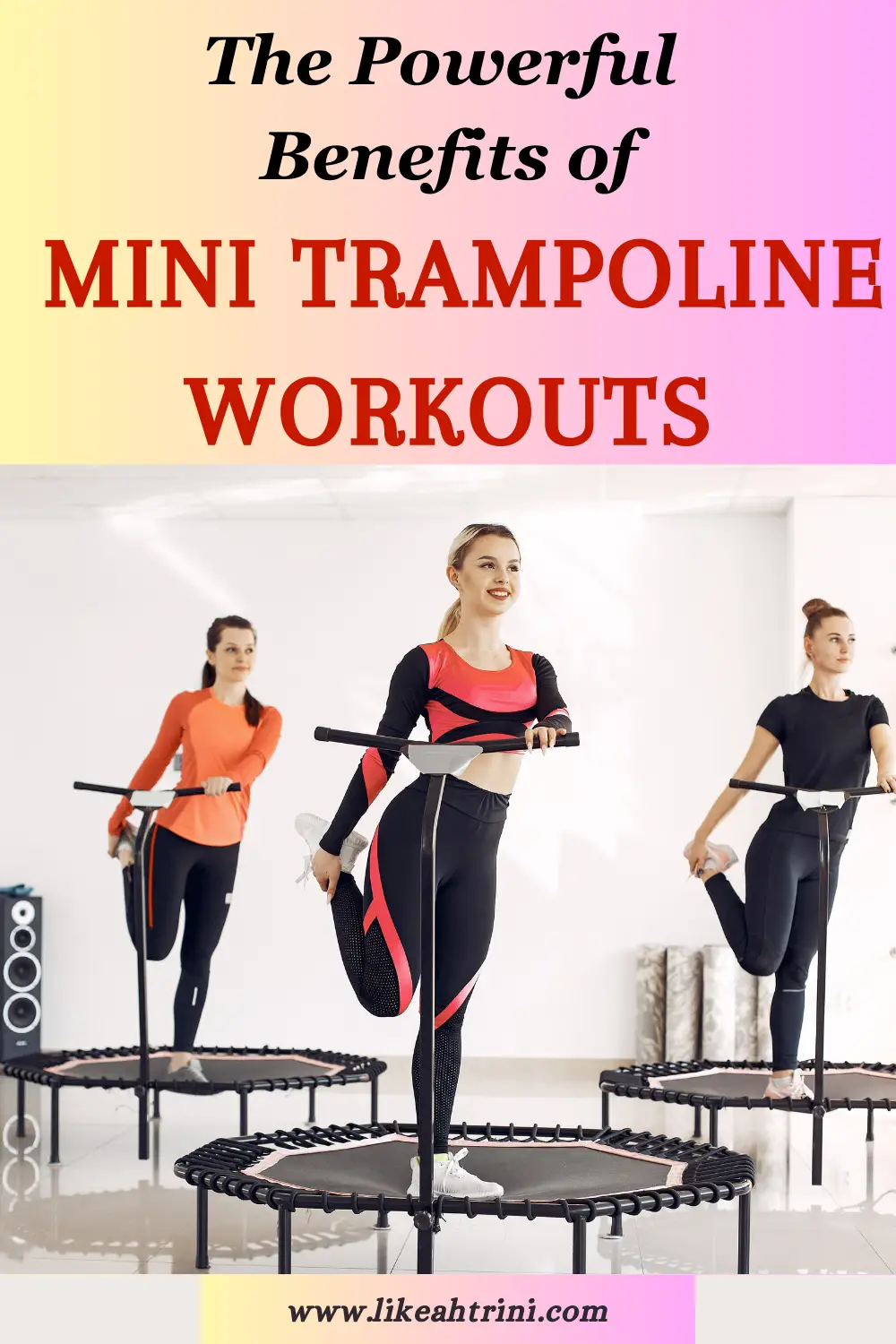Are you tired of boring workouts that feel like a chore? Well, it’s time to bounce into something more exciting and effective. In this article, we’re diving into the incredible world of rebounding and why embracing a mini trampoline in your fitness routine is an absolute game-changer.
Rebounding as an exercise has a long history, with roots tracing back centuries to when Eskimos used animal skins for bouncing and springing.
The modern form of the trampoline, which is the basis for rebounding, was invented in the 1930s by George Nissen. He devised the idea while observing trapeze artists who used safety nets to do tricks. Nissen thought of creating a similar device that could provide a safe and fun way to exercise and perform acrobatics.
Years later with the help of his coach Larry Griswold, he was able to patent his ‘tumbling device‘ which eventually became known as a trampoline after the Spanish word ‘trampolin‘ which means springboard or diving board.
Since then, trampolines and rebounding exercises have evolved gaining popularity as effective ways to stay fit and healthy.

What is Rebounding?
In simple terms, rebounding refers to exercise that is done by bouncing on a trampoline.
What is The Difference between a Rebounder and a Trampoline?
A rebounder is a mini trampoline specifically designed for fitness and rehabilitation. Rebounders are usually closer to the ground, more compact (typically 3 to 5 feet in diameter) and are meant to accommodate only one person. On the other hand, a trampoline can be larger, accommodating several persons at once and is generally used for fun and recreation.
What Are Some of the Benefits of Rebounding With a Mini Trampoline?
Not only is rebounding fun and energising, but it also offers a range of health benefits.
A study published by NASA in the Journal of Applied Physiology in 1980 focused on the benefits of rebounding for astronauts to counteract the negative effect of prolonged weightlessness on their bones and muscles. The study showed that rebounding is an effective exercise for maintaining bone density and muscle strength.
Weight Loss
Exercising on a rebounder engages the entire body, elevating the heart rate and leading to calorie burning. It involves using large muscle groups, boosting the metabolism over time and encouraging calorie burning even at rest.
Low Impact Workout
Rebounding is a low-impact form of exercise as there are no jarring movements on the floor. This reduces stress on the joints and lowers the risk of strain and injury, while still providing an effective workout.
Consistency
Bouncing up and down is an enjoyable activity…just ask children.
Many adults find that exercising on a mini trampoline makes workouts fun rather than feeling like a chore. They start looking forward to their daily exercise, making it a habit and an easy way to incorporate daily movement into their lives. Consistency coupled with healthy eating, is key when it comes to weight loss. So put on your favourite movie, podcast or playlist and start moving!
Improved Blood Circulation
Bouncing exercises are great for the cardiovascular system as they increase the heart rate and oxygen uptake often comparable to, and in some cases, better than, other forms of cardio exercise.
This dynamic motion circulates blood throughout the body and pumps oxygen-rich blood to various organs. Enhanced circulation means that cells receive oxygen more efficiently leading to enhanced energy levels, brain function, better metabolism and immune system support, among other benefits.
Detoxifying the Lymphatic System
Rebounding may help flush out the lymphatic system. a vital part of toxin removal and immune system health. Unlike the circulatory system, which circulates blood via the heart, the lymphatic system lacks a pump and relies on movement for circulation. This is where rebounding becomes beneficial.
Bouncing on a mini trampoline opens and closes the one-way valves in the lymphatic system promoting the flow of lymph. This helps to transport waste, toxins and pathogens where they can be filtered and eliminated from the body.
Builds Bones and Joints
Rebounding is a bodyweight-bearing activity which plays an essential part in improving bone density. The stimulation of bone cells encourages the growth of new bone tissue making it effective against osteoporosis and age-related bone loss.
For joint health, the bouncing movements contribute to the distribution of the fluid that cushions the joints resulting in reduced friction and smoother movement. Also, these movements strengthen the muscles that provide support to the joints.
Core Strength
A hidden bonus of using a mini trampoline is the gradually increasing core strength. With each joyful bounce your abdominal muscles are engaged to maintain balance, steadiness and controlled movements. Over time, these muscles become stronger and more resilient.
Relieving Depression, Improving Mental Health and Stress Relief
In our fast-paced world, rebounding offers a valuable self-care opportunity and a means to alleviate stress contributing to mental well-being. It effectively relieves tension, acting like a massage for the entire body.
The motions resemble the bouncing and shaking movement in the ancient practice of Qigong, where it is used to disperse stagnant energy and reduce bodily stress.
Rebounding triggers the release of endorphins often referred to as the ‘feel-good’ hormones. These endorphins can uplift your mood, alleviate mild depression and anxiety and provide an outlet for pent-up frustrations and distracting from daily concerns.

Better Skin and Hair
Rebounding isn’t solely for weight loss – it surprisingly extends its benefits to your skin and hair.
The act of rebounding can actually stimulate collagen production. Collagen a crucial protein abundant in our bodies plays a pivotal role in our skin, bones, tendons and other connective tissues. For our skin, it is responsible for maintaining elasticity and suppleness.
It has been shown that stress can negatively impact collagen and consequently, skin health. This can manifest as wrinkles and premature signs of aging. Lower stress levels can potentially improve skin issues such as acne, psoriasis and eczema.
Rebounding enhances blood flow bringing oxygen to the skin. Improved lymph circulation helps get rid of toxins and contributes to clearer skin.
Furthermore, the combination of detoxification, improved circulation and potential weight loss has been associated with reducing the appearance of cellulite. Studies have shown that there is a link between the accumulation of lymph due to a stagnant lymphatic system and cellulite. Stimulation of the lymphatic system helps to redistribute fluid buildup potentially decreasing the appearance of cellulite.
As for the hair, with improved circulation, essential nutrients can effectively reach the hair follicles promoting healthier and shinier hair while also encouraging growth. Many of us have experienced hair loss during high-stress periods. Therefore reduced stress through rebounding may foster better hair growth and maintenance.
Convenient
The mini trampoline occupies very little space and can be used almost anywhere – whether it’s your bedroom, living room, porch or backyard. This makes it suitable for working out in small apartments or with limited room. Plus you are not at the mercy of the weather – you can get a full-body workout indoors.
Time-efficient
Surprisingly, a rebounding workout as short as 10 minutes can be as effective as 20 minutes of jogging.
Family-friendly fun
Rebounding is not just for individuals, it’s a workout that the entire family can enjoy. Its adaptable intensity suits both beginners and advanced exercisers and since it’s low-impact it is gentler on joints.
Today an array of online videos, apps and virtual classes make it easier than ever to work out on your mini trampoline in the comfort of your home.
Variety
Beyond the basic bounce, there is a myriad of other exercises that can be performed on a rebounder, such as:
- Running in place
- Jumping jacks
- Side-to-side skiing
- Jump squats
- High knee lifts
In addition, you can incorporate light hand weights into your workouts for upper body toning.
What to Look For When Selecting A Mini Trampoline
When on the hunt for a mini trampoline for your rebounding adventures, there are several important factors to consider.
Size and Space – Start by assessing the trampoline’s size. Opt for one that provides ample bouncing area for your needs while still fitting comfortably within your available space.
Weight Capacity – Mini trampolines have varying weight limits, based on their design. It is essential to confirm the maximum weight capacity to ensure it suits your weight or that of your family members.
Stability – Look for a trampoline with non-slip feet to prevent it from shifting while in use.
Solid Frame – Prioritize trampolines that have frames made out of durable materials like steel.
Portability – If you plan to frequently move the trampoline, consider a foldable model for easy transport and storage.
Adjustable Handlebar– Some mini trampolines feature an adjustable handlebar. This is beneficial, especially for beginners, the elderly or anyone requiring additional support and stability during workouts.
Good Reviews – It is advisable to read a range of reviews to gauge customer satisfaction, providing insights into the trampoline’s potential strengths and limitations.
Resources and References
For more information on the benefits of using a mini trampoline, see the following links:
- Effects of a mini-trampoline rebounding exercise program on functional parameters, body composition and quality of life in overweight women.
- Effects of rebound exercises on overweight and obese adults: A scoping review
- Body acceleration distribution and O2 uptake in humans during running and jumping
Conclusion
Wrapping up our exploration of rebounding on a mini trampoline, it’s clear that this is more than just a workout – it’s a gateway to a healthier lifestyle. The benefits are as exciting as they are varied, promising a holistic approach to fitness. And don’t let its simplicity fool you – this exercise is suitable for everyone, regardless of age or fitness level.
When you’re ready to take the leap into rebounding, keep in mind the pointers for selecting the right mini trampoline for your needs.
If you’re already a seasoned bouncer, feel free to share your rebounding experiences in the comments.
Disclaimer: The information provided in this article is for educational and informational purposes only. It is not a substitute for professional medical advice, diagnosis, or treatment. Always consult with a qualified healthcare provider before starting any new exercise program or making changes to your existing routine.
Image Credit:Image by prostooleh on Freepik


